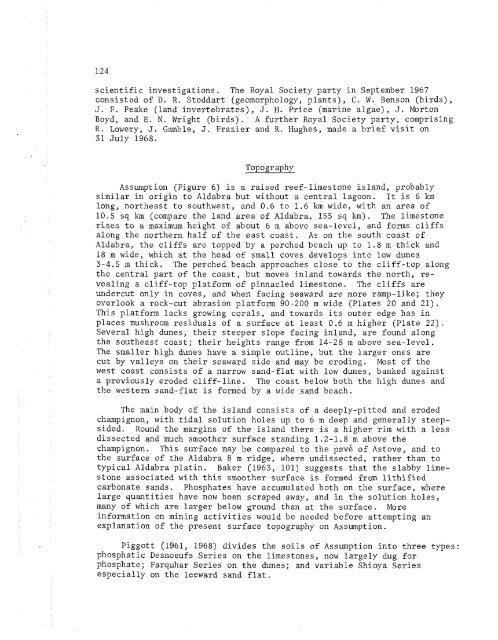ATOLL RESEARCH BULLETIN - Smithsonian Institution
ATOLL RESEARCH BULLETIN - Smithsonian Institution
ATOLL RESEARCH BULLETIN - Smithsonian Institution
Create successful ePaper yourself
Turn your PDF publications into a flip-book with our unique Google optimized e-Paper software.
scientific investigations. The Royal Society party in September 1967<br />
consisted of D. R. Stoddart (geomorphology, plants), C. W. Benson (birds),<br />
J. F. Peake (land invertebrates), J. H. Price (marine algae), J. Morton<br />
Boyd, and E. N. Wright (birds). A further Royal Society party, comprising<br />
R. Lowery, J. Gamble, 3. Frazier and R. Hughes, made a brief visit on<br />
31 July 1968.<br />
Topography<br />
Assunlption (Figure 6) is a raised reef-limestone island, probably<br />
similar in origin to Aldabra but without a central lagoon. It is 6 km<br />
long, northeast to southwest, and 0.6 to 1.6 km wide, with an area of<br />
10.5 sq km (compare the land area of Aldabra, 155 sq km). The limestone<br />
rises to a maximum height of about 6 m above sea-level, and forms cliffs<br />
along the northern half of the east coast. As on the south coast of<br />
Aldabra, the cliffs are topped by a perched beach up to 1.8 m thick and<br />
18 m wide, which at the head of small coves develops into low dunes<br />
3-4.5 m thick. The perched beach approaches close to the cliff-top along<br />
the central part of the coast, but moves inland towards the north, re-<br />
vealing a cliff-top platform of pinnacled limestone. The cliffs are<br />
undercut only in coves, and when facing seaward are more ramp-like; they<br />
overlook a rock-cut abrasion platform 90-200 m wide (Plates 20 and 21).<br />
This platform lacks growing corals, and towards its outer edge has in<br />
places mushroom residuals of a surface at least 0.6 m higher (Plate 22).<br />
Several high dunes, their steeper slope facing inland, are found along<br />
the southeast coast; their heights range from 14-28 m above sea-level.<br />
The smaller high dunes have a simple outline, but the larger ones are<br />
cut by valleys on their seaward side and may be eroding. Most of the<br />
west coast consists of a narrow sand-flat with low dunes, banked against<br />
a previously eroded cliff-line. The coast below both the high dunes and<br />
the western sand-flat is formed by a wide sand beach.<br />
The main body of the island consists of a deeply-pitted and eroded<br />
champignon, with tidal solution holes up to 6 m deep and generally steep-<br />
sided. Round the margins of the island there is a higher rim with a less<br />
dissected and much smoother surface standing 1.2-1.8 m above the<br />
champignon. This surface may be compared to the pav; of Astove, and to<br />
the surface of the Aldabra 8 m ridge, where undissected, rather than to<br />
typical Aldabra platin. Baker (1963, 101) suggests that the slabby lime-<br />
stone associated with this smoother surface is formed from lithified<br />
carbonate sands. Phosphates have accumulated both on the surface, where<br />
large quantities have now been scraped away, and in the solution holes,<br />
many of which are larger below ground than at the surface. More<br />
information on mining activities would be needed before attempting an<br />
explanation of the present surface topography on Assumption.<br />
Piggott (1961, 1968) divides the soils of Assumption into three types:<br />
phosphatic Desnoeufs Series on the limestones, now largely dug for<br />
phosphate; Farquhar Series on the dunes; and variable Shioya Series<br />
especially on the leeward sand flat.

















